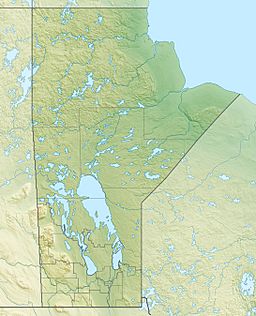Lynx Lake (Manitoba) facts for kids
Quick facts for kids Lynx Lake |
|
|---|---|
| Location | Manitoba |
| Coordinates | 54°36′34″N 101°33′24″W / 54.60944°N 101.55667°W |
| Lake type | Glacial Lake |
| Primary inflows | none |
| Primary outflows | Lake Athapapuskow |
| Basin countries | Canada |
| Max. length | 1.6 km (0.99 mi) |
| Max. width | .6 km (0.37 mi) |
| Shore length1 | 5.5 km (3.4 mi) |
| Surface elevation | 304 m (997 ft) |
| Islands | 7 |
| 1 Shore length is not a well-defined measure. | |
Lynx Lake is a beautiful lake located in Manitoba, Canada. It is about 10 kilometers (or 6 miles) southeast of a place called Bakers Narrows. This lake is special because it is a glacial lake, which means it was formed by huge sheets of ice (glaciers) thousands of years ago.
The water from Lynx Lake flows into another lake called Lake Athapapuskow. From there, its water eventually joins the Nelson River system. This river then carries the water all the way to Hudson Bay. This whole area is part of the larger Hudson Bay drainage basin, which is like a giant funnel that collects water from a wide region.
Exploring Lynx Lake
Lynx Lake is a relatively small lake. It is about 1.6 kilometers (1 mile) long and 0.6 kilometers (0.4 miles) wide. The lake sits in a part of Canada known as the Churchill River Upland. This area is famous for its Midwestern Canadian Shield forests.
Nature Around the Lake
The land around Lynx Lake is covered by a mixed forest. You can find different types of trees here. These include black spruce, white spruce, jack pine, and trembling aspen.
The shoreline of the lake is quite interesting. It has steep, rocky ridges that are not very even. There are also wet, boggy areas called muskeg. Muskeg is a type of wetland with lots of moss and peat.
Fish in the Lake
If you like fishing, Lynx Lake is home to northern pike. These are popular fish known for their long bodies and sharp teeth.
How Lynx Lake Got its Name
The name "Lynx Lake" was officially given to this body of water in 1941.



